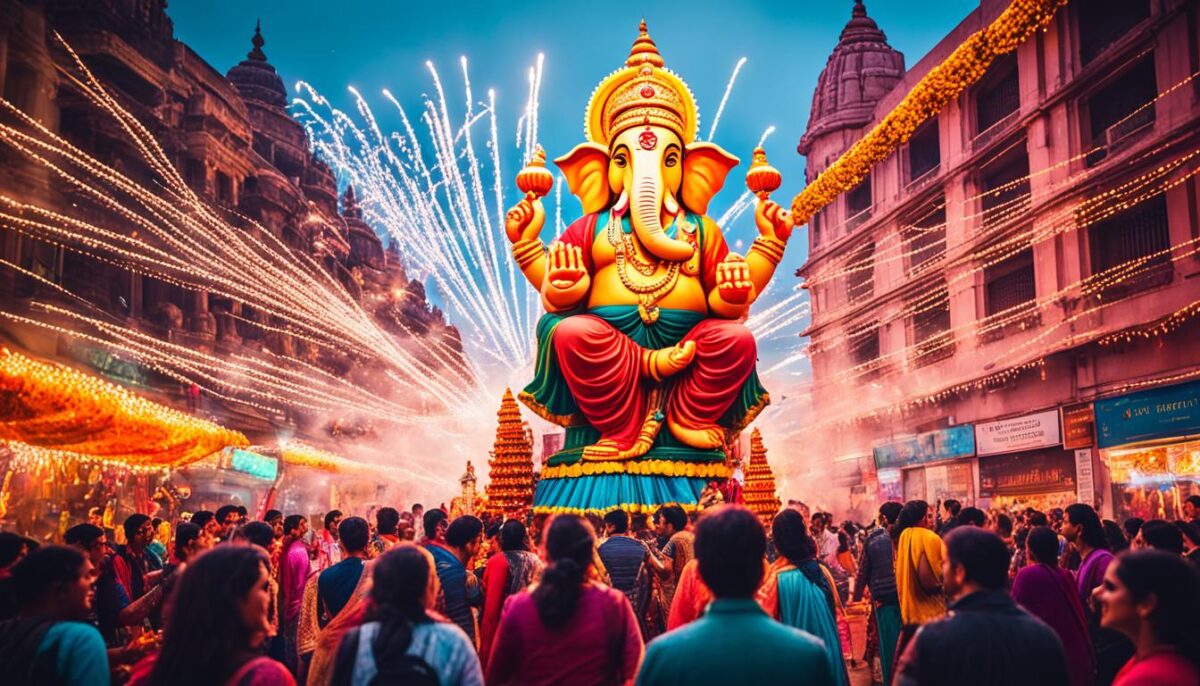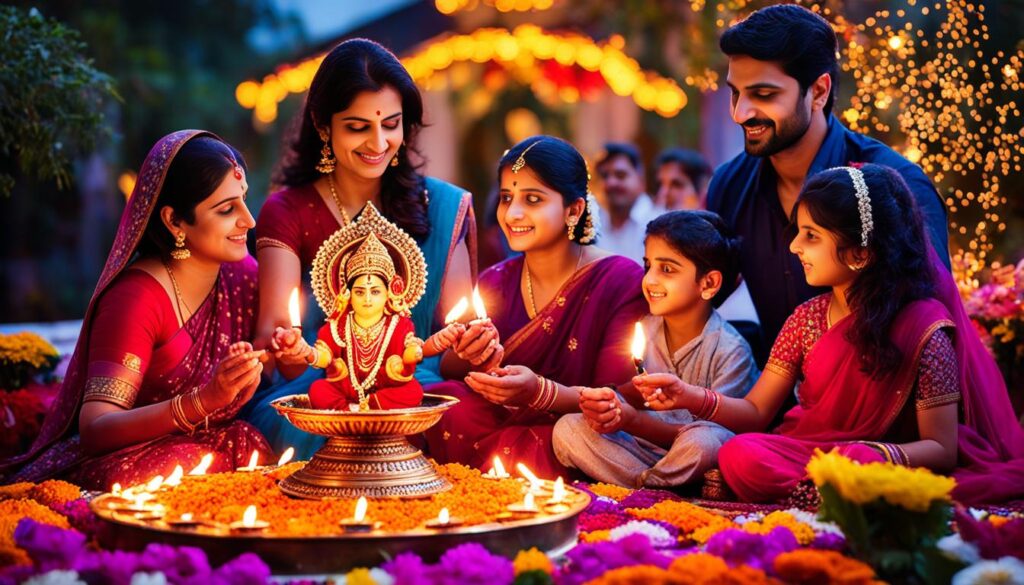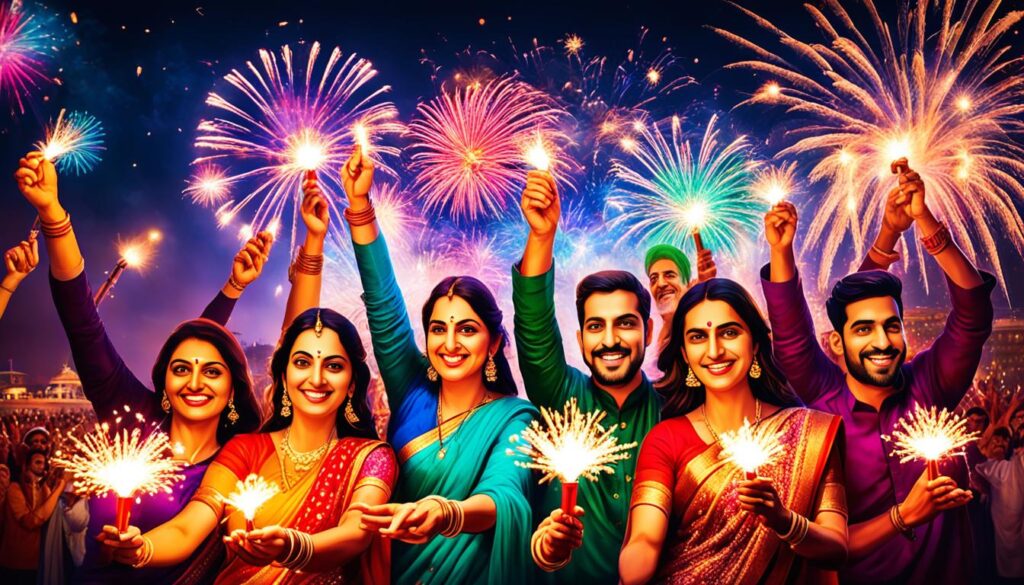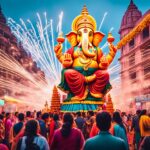Imagine experiencing a festival that celebrates light beating darkness. A holiday that highlights good winning over evil, and the victory of knowledge. This is Dipawali, or Diwali, India’s grandest festival.1
The name “Dipawali” comes from Sanskrit, meaning “row of lights.” It marks the significance of brightly lit clay lamps outside homes. This event is as crucial for Hindus as Christmas is for Christians, and it’s observed by Sikhs, Jains, and some Buddhists globally.1
Key Takeaways
- Dipawali, or Diwali, is India’s biggest and most important holiday, celebrated by Hindus, Sikhs, Jains, and some Buddhists.
- The festival symbolizes the triumph of light over darkness, good over evil, and knowledge over ignorance.
- Diwali celebrations span over five days and include rituals like cleaning homes, decorating with clay lamps and rangoli patterns, exchanging gifts, and enjoying traditional sweets.
- The festival holds deep spiritual significance for different religious communities, celebrating events like the return of Lord Rama, the release of Guru Hargobind Singh, and the attainment of moksha by Lord Mahavira.
- Dipawali has gained global recognition and is now celebrated by Hindu, Sikh, and Jain communities around the world.
Origins and Meaning of Dipawali
The term “Dipawali” comes from the ancient language Sanskrit. It means “row of lights.”2 This festival is named after the line of little clay lamps. These lamps represent the light inside us that protects from darkness inside.2 Light winning over dark and good defeating evil is the main idea of Dipawali.
Significance of the Word “Dipawali”
The term “Dipawali” comes from Sanskrit “dipavali,” which means “row of lights.”2 It shows the tradition of placing rows of clay lamps, known as diyas, outside homes during the celebration of Dipawali.
Symbolic Representation of Light over Darkness
During Dipawali, people light diyas and put up bright decorations. This symbolizes the spiritual “victory of light over darkness, and knowledge over ignorance.”2 This symbol is very important during the Dipawali celebration. It shows the win of wisdom and goodness over bad and negative things.
Dipawali: A Pan-Indian Festival
Through the years, Dipawali has grown to be a significant festival across India. It is celebrated by Hindu, Sikh, and Jain communities.3 This festival celebrates the return of King Rama widely across India and other countries.3
Celebration by Hindus
Hindus see Dipawali as welcoming the return of Lord Rama and Sita to Ayodhya. They celebrate Goddess Durga’s victory over Mahisha too.4 In northern India, Dipawali occurs on the Kartika month’s new moon day.4 South India has its celebrations one day earlier.4
Celebration by Sikhs
For Sikhs, Dipawali is about celebrating the release of Guru Hargobind Singh from prison in 1619.4 They observe Bandi Chhor Divas during Diwali to remember this event.4
Celebration by Jains
Jains mark Dipawali to celebrate Lord Mahavira’s spiritual awakening in 527 B.C.4 This is a special day for them, resembling Diwali, when Vardamana Mahavira reached nirvana.4
Regional Variations in Dipawali Celebrations
India celebrates [dipawali regional traditions] with unique customs. Regional differences make the festival rich and diverse.5
Northern Indian Traditions
[In northern india dipawali], people honor King Rama’s return to Ayodhya. He defeated Ravana, and lights symbolize the occasion.5
Southern Indian Traditions
[Southern india dipawali] marks Lord Krishna’s victory over Narakasura. The festival focuses on this triumph.5
Western Indian Traditions
[Western india dipawali] signifies Lord Vishnu’s action. He sent King Bali to the nether world. This event is very important.5
Five Days of Dipawali Festivities
The6 Dipawali celebrations last five days. Each day brings special meaning and traditions.6
Day One: Cleaning and Shopping
Day one is Dhanteras, when people start cleaning. They buy gold, silver, and new clothes for luck.7 In Gujarat, Dhanteras might be more important than Diwali. People pray to the gods Lakshmi, Kuber, and Ganesha.7
Day Two: Decorations and Rangoli
Kali Chaudas, aka Narak Chaturdasi, is day two. It’s about Lord Krishna defeating the demon Narakasur.7 Homes are lit with lamps and colorful rangoli patterns made.
Day Three: Lakshmi Puja and Celebrations
The third day focuses on Lakshmi puja. Families pray for wealth and happiness.7 Nations across India light up with sparklers and fairy lights. They enjoy feasts and fireworks too.
Day Four: New Year’s Day
Day four is a new year in many parts, like Gujarat’s Bestu Baras. Northern India celebrates with Govardhan Pooja and Vishwakarma Day. It marks the start of new opportunities and beginnings.
Day Five: Bhai Dooj
Bhai Dooj is day five, celebrating siblings. Brothers visit sisters who make them sweets for luck.7 It highlights the strong family bonds during Dipawali.
Dipawali Decorations and Traditions
Dipawali is known for diya lamps, rangoli on the floor, and fireworks.2 It’s about spreading light in the darkness.2 People decorate with these items everywhere.8 They also give gifts and share sweets with loved ones.2
Diya Lamps and Rangoli Designs
The festival lasts for 5 days and is full of decorations.8 In Varanasi, a million diyas shine.8 Homes are welcomed with rangoli and diyas for Goddess Lakshmi.8
Fireworks and Sparklers
The celebration includes big fireworks and sparklers.2 These show that good beats evil and light wins.2 It’s an important part of the holiday.2
Gift-Giving and Feasting
People also exchange gifts and share tasty food.2 This brings everyone closer.2 It’s a special time to be with family and friends.2
Significance of Dipawali for Hindus
Dipawali is spiritually important for Hindus. It marks Lord Rama’s return to Ayodhya after 14 years. People in Northern India especially see it as a time of victory.1
Celebrating the Return of Lord Rama
The tale of Lord Rama’s comeback is from Hindu myths. It’s a big deal for the Hindu community. Dipawali is about more than just celebrating. It’s about the win of good over bad, and doing what’s right.1
Victory of Goddess Durga over Evil
At Dipawali, they also remember Goddess Durga’s big win. She beat the evil demon Mahisha. This shows us that good and truth can beat bad and lies.1
These stories are key to what Dipawali means. They remind us about doing what’s right, keeping the faith, and fighting against the bad.1
Significance of Dipawali for Sikhs
Dipawali means a lot to Sikhs. It marks two very important events. Firstly, it celebrates when the Sixth Sikh Guru, Hargobind Singh, was freed in 1619. This day holds a deep meaning for Sikh followers.9 Secondly, on this day in 1577, the foundation stone of the Golden Temple was laid. The Golden Temple is the most sacred place for Sikhs.9
Release of Guru Hargobind Singh
For Sikhs, the release of Guru Hargobind Singh is very special during Dipawali. He was held captive by the Mughal Emperor Jahangir in 1619. But, he was set free on Dipawali. This event is key in Sikh history.9
Laying of the Golden Temple’s Foundation Stone
The laying of the Golden Temple’s foundation stone in 1577 is remembered too. It’s celebrated because it marks the beginning of building the holiest Sikh site. The Golden Temple is a place of great importance and worship for Sikhs.9
Significance of Dipawali for Jains
For Jains, Dipawali is very important. It celebrates Lord Mahavira attaining moksha.10 This means spiritual freedom. It marks the end of the soul’s journey through birth and rebirth.
Lord Mahavira’s Attainment of Moksha
Jains believe Lord Mahavira achieved moksha on October 15, 527 BCE. It happened in Pawapuri during the Kartika month.10 This celebration shows his spiritual enlightenment and freedom from the cycle of life and death.
Jains start their new year with Dipawali.10 Their first day, Pratipada, follows Dipawali. Since the Diwali of 1974, their current year is 2501. For business people, this time is seen as a perfect start for their new financial year.
Jain temples on Diwali morning present Nirvan Ladoo, a special sweet, in memory of Lord Mahavira. This marks his moksha.10 Jains choose not to use fireworks on Diwali. They do this to respect life and avoid harm, following the principle of Ahimsa.
The Swetambar sect fasts for two days to honor Mahavira’s sacrifices. This highlights the festival’s spiritual aspects.10 Jains also visit places like Pawapuri, Nalanda, to pray and remember Lord Mahavira.
On Dipawali, Jains buy new account books. This symbolizes a fresh start for their businesses. They hope for luck and success in the upcoming year.10
Dipawali Festivities Around the World
While Dipawali hails from India, it’s now cheered worldwide. Hindu, Sikh, and Jain communities join in.11 Places like the U.S., U.K., Canada, and Singapore light up with joy. They celebrate with festival of lights traditions, from gifts to fireworks.12
In Singapore, Deepvali in Little India shines on November 12-13, 2023.12 Over in Kuala Lumpur, Malaysia, the Deepavali Carnival lights up November 3-11, 2023.12 In Leicester, United Kingdom, the Abbey Park – Leicester Diwali 2023 celebration is bright from November 9-14, 2023.12
Yangon, Myanmar, brightens up at The Coriander Leaf on November 12, 2023.12 In Johannesburg, South Africa, it’s the SoluLab Diwali Dhamaka event on November 20, 2023.12 Far across the sea in Bangkok, Thailand, the Diwali Cruise sets sail November 12, 2023.12 And in Jakarta, Indonesia, there’s the festive Sounds of Diwali on the same day.12 Lastly, in Kathmandu, Nepal, the Grand Tihar Festival runs from November 10-14, 2023.12
These celebrations show Dipawali‘s broad appeal and deep cultural ties. Hindu, Sikh, and Jain communities worldwide partake.111
Traditional Dipawali Sweets and Delicacies
The Dipawali celebrations are filled with many traditional Indian sweets. Jalebi, kaju katli, gulab jamun, and burfi are among the favorites.13 People exchange these sweets as gifts and enjoy them with loved ones.
Jalebi
Jalebi is a must-have sweet in North India. It is a spiral sweet made from all-purpose flour soaked in sugar syrup.13 The Jalebi Recipe provides two ways to make this delicious item.14
Kaju Katli
Pista barfi and kaju katli are popular sweets, wrapped in silver leaf for special times.13 The Kaju Katli Recipe shows how to make a cashew fudge with just cashews and sugar.14
Gulab Jamun
Gulab jamun is a favorite all over India. It is made of khoya, flour, and sugar syrup.13 For those new to cooking, a simplified Gulab Jamun Recipe uses milk powder.14
Burfi
At Indian sweet shops, you’ll find pista barfi and kaju katli, usually with silver leaf.13 The Besan Burfi Recipe offers a sweet with gram flour, sugar, and cardamom. It’s common in North India.14
Cultural Impact and Influence of Dipawali
The festival of Dipawali greatly influences Indian culture and is known around the world.15 It highlights light beating darkness and good beating evil. These universal messages of starting anew and sharing joy are understood by many. Dipawali represents India’s diverse history and its lively celebrations appeal to people everywhere, making it a global event.16
Dipawali cultural impact shows how the festival is crucial to India’s way of life.16 Diwali boosts the economy, contributing about 1-2% of the country’s yearly GDP. This is through more shopping, tourism, and other activities related to the festival.16 Gifting is a huge part of Diwali which boosts retail sales massively, causing a 30% rise in spending. It also increases sales for consumer goods by up to 25%.16
The dipawali global influence reaches beyond India, celebrated by followers of Hinduism, Sikhism, and Jainism worldwide.17 It’s not only an Indian event but is also celebrated in other parts of Asia and the globe, showing its broad appeal.17 Its festive lights, gifts, and joy bring people together, making Dipawali an international festival that signifies light, togetherness, and wealth.
Conclusion
The festival of Dipawali is deeply spiritual and loved worldwide.15 More than a billion people in India and around the globe celebrate it, making it a huge event.18 People light lamps or diyas, signifying light triumphing over darkness and good beating evil. Diwali also marks the start of the new year in India, bringing joy and beginning new projects.
During Diwali, people light diya lamps and create rangoli designs. They also share gifts and enjoy traditional sweets.19 This represents the victory of light and good, welcoming new starts.19 Families draw rangoli at home entrances and cook delicious meals, including samosas and Gulab jamun, for a special feast.18 Exchanging gifts and sweets shows love and goodwill among people.
Diwali is a significant festival for Hindus, Sikhs, and Jains, celebrating the victory of light and love.15 It brings these communities together, showing their shared cultural roots.15 Hinduism, the oldest living religion, has different stories of Diwali, varying by region.15 Sikhs remember Guru Hargobind’s freedom, and Jains honor Lord Mahavira’s enlightenment. This global and lasting impact makes Dipawali an extraordinary event.
FAQ
What is the meaning of the word “Dipawali”?
“Dipawali” comes from “dipavali,” which means “row of lights” in Sanskrit. It’s the fest of lights. People light clay lamps everywhere to beat spiritual darkness.
What is the central theme of the Dipawali celebration?
Dipawali is about light winning over darkness and good crushing evil. It’s a key mythological tale for Hindus.
How is Dipawali celebrated by different religious communities in India?
Hindus, Sikhs, and Jains celebrate Dipawali across India. For Hindus, it marks Lord Rama’s return. Sikhs honor Hargobind Singh’s release, and Jains mark Lord Mahavira’s spiritual awakening.
What are the regional variations in Dipawali celebrations across India?
In northern India, Dipawali celebrates King Rama’s homecoming. South India honors Lord Krishna’s victory over Narakasura. The west marks Lord Vishnu’s act to serve the demon King Bali.
What are the five days of Dipawali festivities?
It lasts five days. First, homes get cleaned, gold is bought, or new utensils. Next, they light the lamps and make rangoli. The third day is for Lakshmi puja, feasting, and fireworks. The fourth day starts the new year, and the last one celebrates siblings.
What are the key traditions and decorations associated with Dipawali?
In Dipawali, lighted diyas, rangoli designs, and fireworks are common. They symbolize the victory of light over darkness.
What is the spiritual significance of Dipawali for Hindus?
Dipawali is spiritually deep for Hindus. It honors Lord Rama’s return and Goddess Durga’s victory. These signify the triumph of good over evil.
How is Dipawali celebrated by the Sikh community?
Sikhs celebrate Dipawali because Hargobind Singh was freed in 1619. Also, the Golden Temple’s foundation stone was laid in 1577 on this day.
What is the significance of Dipawali for the Jain community?
For Jains, Dipawali celebrates Lord Mahavira’s moksha, or spiritual liberation. It highlights the soul’s victory over the material world.
How is Dipawali celebrated around the world?
Dipawali is now a global festival, celebrated by Hindus, Sikhs, and Jains. Countries like the U.S., U.K., Canada, and Singapore mark it with lights, gifts, and fireworks.
What are some of the traditional Dipawali sweets and delicacies?
Popular sweet treats include jalebi, kaju katli, gulab jamun, and burfi. These are exchanged as gifts and enjoyed during the festival.
Source Links
- https://kids.nationalgeographic.com/pages/article/diwali
- https://en.wikipedia.org/wiki/Diwali
- https://ideas.hallmark.com/articles/fall-ideas/what-is-diwali/
- https://storytrails.in/culture/of-diwali-and-deepavali/
- https://pravinchandanofficial.medium.com/exploring-the-cultural-contrasts-diwali-celebrations-in-north-and-south-india-4b9140bd2f77
- https://wonderopolis.org/wonder/What-Are-the-Five-Days-of-Diwali
- https://www.ganeshaspeaks.com/predictions/astrology/5-days-of-diwali/
- https://www.asiahighlights.com/india/diwali-decorations
- https://www.sikhiwiki.org/index.php/Diwali
- https://en.wikipedia.org/wiki/Diwali_(Jainism)
- https://www.bbc.co.uk/newsround/15451833
- https://www.headout.com/blog/diwali-around-the-world/
- https://www.tasteofhome.com/collection/the-most-popular-diwali-sweets/
- https://www.indianhealthyrecipes.com/diwali-sweets-recipes-diwali-recipes/
- https://www.nationalgeographic.com/history/article/diwali-history-customs-indian-festival-of-lights
- https://www.linkedin.com/pulse/lighting-up-lives-diwalis-transformative-sloff
- https://timesofindia.indiatimes.com/life-style/events/when-in-diwali-in-2019-history-significance-importance-story-and-all-you-need-to-know/articleshow/71723775.cms
- https://www.linkedin.com/pulse/diwali-deepavali-sijo-jose-qwzsc
- https://www.eyfoundation.com/uk/en/news/blog/significance_of_diwali_from_a_young_persons_perspective.html



